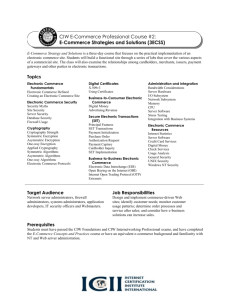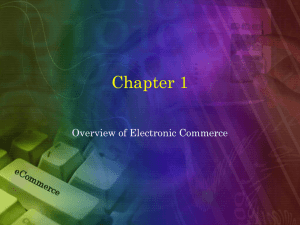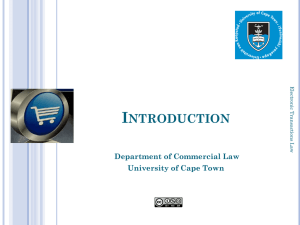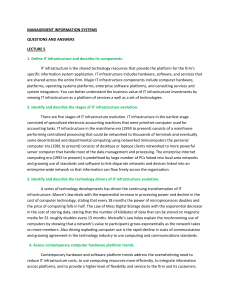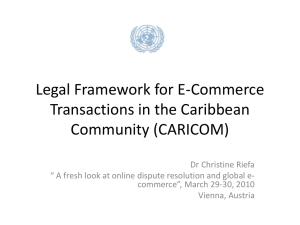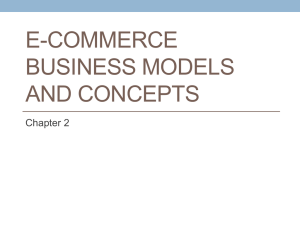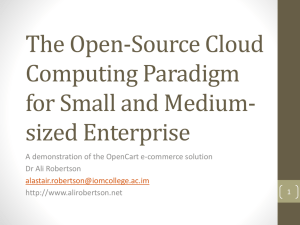Electronic Commerce
advertisement
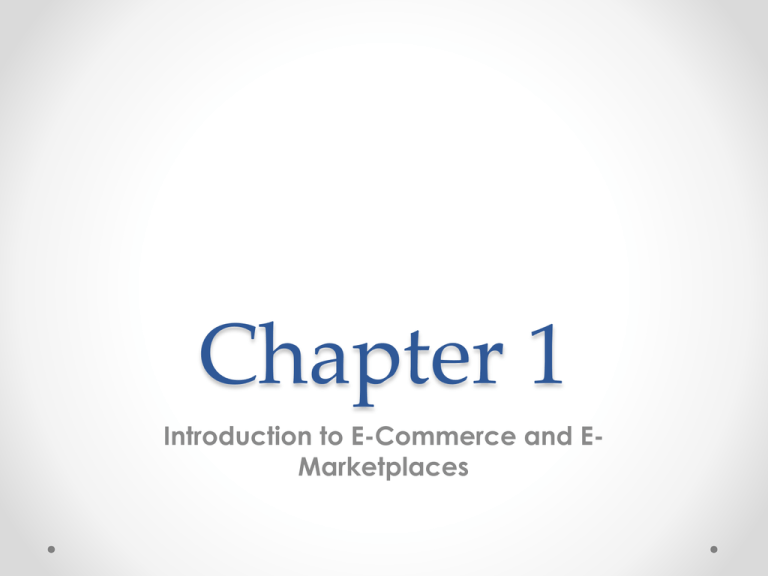
Chapter 1 Introduction to E-Commerce and EMarketplaces Learning Objectives 1. Define electronic commerce (EC) and describe its various categories. 2. Describe and discuss the content and framework of EC. 3. Describe the major types of EC transactions. 4. Describe the drivers of EC. 5. Discuss the benefits of EC to individuals, organizations and society. 6. Discuss e-commerce 2.0 and social media. Learning Objectives 7. Describe social commerce and social software. 8. Understand the elements of the digital world. 9. Describe the major environmental business pressures and organizational responses. 10. Describe some EC business models. 11. List and describe the major limitations of EC. Electronic Commerce: Definitions and Concepts • Defining Electronic Commerce o *Electronic commerce (EC) • Defining E-Business o *E-business Electronic Commerce: Definitions and Concepts • Major EC Concepts o Pure Versus Partial EC o EC Organizations • Electronic Markets and Networks E-Commerce as Percent of Total Value: 2003-2011 The Electronic Commerce Field: Growth, Content, Classification, and a Brief History • The Content and Framework of ECommerce • An EC Framework A Framework for Electronic Commerce The Electronic Commerce Field: Growth, Content, Classification, and a Brief History • Classification of EC by the Nature of the Transactions and the Relationships Among Participants o o o o o o o o o *Business-to-Business (B2B) *Business-to-Consumer (B2C) *Business-to-Business-to-Consumer (B2B2C) *Consumer-to-Business (C2B) *Intrabusiness EC *Business-to-Employees (B2E) *Consumer-to-Consumer (C2C) *Collaborative Commerce *E-Government Categories of Transactions in E-Commerce The Electronic Commerce Field: Growth, Content, Classification, and a Brief History • A Brief History of EC o The Interdisciplinary Nature of EC o The Google Revolution o Cyber Monday, Single Day o Social Commerce • F-Commerce o EC Failures Drivers and Benefits of E-Commerce • The Drivers of E-Commerce o The Major Drivers of EC • The Benefits of E-Commerce o Opportunities for Entrepreneurs o EC as a Provider of Efficiency, Effectiveness, and of Competitive Advantage The Major Drivers of E-Commerce Growth E-Commerce 2.0: From Social Commerce to Virtual Worlds • *Social Computing • *Web 2.0 • *Social Media o The Difference between Social Media and Web 2.0 • Social Networks and Social Network Services o *Social Network o Social Networking Services o *Social Networking The Social Customer E-Commerce 2.0: From Social Commerce to Virtual Worlds • Enterprise Social Networks • Social Commerce • Virtual Worlds and Second Life o How Students Make Money in a Virtual World • The Major Tools of Web 2.0 The Digital and Social Worlds: Economy, Enterprises, and Society • *The Digital Economy o *Sharing Economy o The Social Impact • *The Digital Enterprise o Smart and Intelligent Enterprise Systems The Digital and Social Worlds: Economy, Enterprises, and Society • *The Social Business (Enterprise) o The Social Business Forum o IBM’s Approach o *Social Business by Design • The Digital Revolution and Society o Disruptive Impacts o *The Social Customer The Changing Business Environment, Organizational Responses, and EC and IT Support • The Changing Business Environment • Performance, Business Pressures, and Organizational Responses and EC Support o The Business Environment and Performance Impact Model o Business Pressures o Organizational Response Strategies o The Major Capabilities of E-Commerce The Business Environment and Performance Model Electronic Commerce Business Models • *Business Model • The Structure and Properties of Business Models o Revenue Models o Value Proposition o Functions of a Business Model • Typical EC Business Models • Classification of Business Models in ECommerce The Major Components of a Business Model The Limitations, Impacts, and the Future of E-Commerce • The Limitations and Barriers of EC o Ethical Issues o Overcoming the Barriers • Why Study E-Commerce? • The Future of EC Managerial Issues 1. Why is B2B e-commerce so essential and successful? 2. Which EC business model should I choose? 3. How can we exploit social commerce? 4. What are the top challenges of EC today? Summary 1. Definition of EC and description of its various categories. 2. The content and framework of EC. 3. The major types of EC transactions. 4. The drivers of EC. 5. Benefits of EC to organizations, consumers, and society. 6. E-commerce 2.0 and social media. Summary 7. Describe social commerce and social software. 8. The elements of the digital world. 9. Business pressures. 10.The major EC business models. 11.Limitations of e-commerce.
